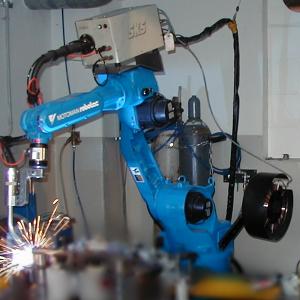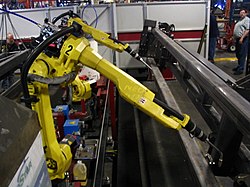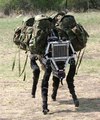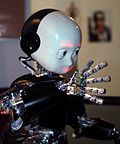Robot

A robot is a machine that can move and do certain tasks and work.
Robots are controlled by a computer program or electronic circuitry. They may be directly controlled by humans. They may be designed to look like humans, in which case their behaviour may suggest intelligence or thought but they do not have feelings. Most robots do a specific job, and they do not always look like humans. They can come in many forms.[1]
In fiction, however, robots usually look like people, and seem to have a life of their own.[2] There are many books, movies, and video games with robots in them. Isaac Asimov's I, Robot is perhaps the most famous.
History
People have been interested in building machines that do work for us for a long time. But it takes time and money to build just one machine, so early ideas were not built. Leonardo da Vinci designed a man-shaped machine to look like a knight in 1464. It would be controlled with ropes and wheels. Other engineers and dreamers drew mechanical men. In 1920, Karel Čapek wrote a story about them, and he used a word from Czech that is connected with 'work': robot.[3]
The most successful robot designs in the 20th century were not made to look like people. They were designed for use. George Devol made the first of these, the Unimate, in 1954, with one arm and one hand. General Motors bought it in 1960. The next year, it started work in a factory in New Jersey, lifting and stacking pieces of metal that were too hot for people to touch.[4] The engineers could program it, and reprogram it if they had to.
Modern robots

Robots have many uses. Many factories use robots to do hard work quickly and without many mistakes. They do not look like people, because they are made to do things. These are 'industrial' robots. Some robots find and get rid of bombs. If someone makes a mistake, the robot is damaged or destroyed, which is better than a person being killed. There are also robots that help at home, to vacuum or run a lawn mower, for example. Such robots must learn about the area of work.
A few robots do surgery in places inside the body where a human hand is too big.[5]
Planet rovers are robots for exploring distant planets. Because it takes a long time to send a radio signal from Earth to another planet, the robots do much of their work alone, without commands from Earth.
People still think of robots as having a shape like a person—two legs, two arms, and a head. ASIMO is one robot that is helping scientists learn how to design and program robots. It can walk, which is not easy to program.
Eastern and western views
Eastern thoughts on robots
Roughly half of all the robots in the world are in Asia, 32% in Europe, and 16% in North America, 1% in Australasia and 1% in Africa.[6] 30% of all the robots in the world are in Japan.[7] Japan has the most robots of any country in the world, and is the leader in the world robotics industry.[8] Japan is actually said to be the robotic capital of the world.[9]
In Japan and South Korea, ideas of future robots have been mainly positive. The positive reception of robots there may be partly because of the famous cartoon robot, 'Astroboy'. China expressed views on robotics that are similar to those of Japan and South Korea, but China is behind both America and Europe in robotic development. The East Asian view is that robots should be roughly equal to humans. They feel robots could care for old people, teach children, or serve as assistants. The popular opinion of East Asia is that it would be good for robots to become more popular and more advanced. This view is opposite to the popular Western view.
"This is the opening of an era in which human beings and robots can co-exist," says Japanese firm Mitsubishi about one of the many human-like robots in Japan.[10] The South Korean Ministry of Information and Communication has predicted that every South Korean household will have a robot by between 2015 and 2020.
Western thoughts on robots
Western societies are more likely to be against, or even fear the development of robots. Science fiction movies and other stories often show them as dangerous rebels against humanity.
The West regards robots as a 'threat' to the future of humans, which is much due to religious influence of the Abrahamic religions, in which creating machines that can think for themselves would almost be playing God.[9][11] Obviously, these boundaries are not clear, but there is a significant difference between the two ideologies.
Robot laws
The writer Isaac Asimov told many stories about robots who had the three laws of robotics to keep humans safe from them.
- A robot may not injure a human being or, through inaction, allow a human being to come to harm.
- A robot must obey orders given to it by human beings, except where such orders would conflict with the First Law.
- A robot must protect its own existence as long as such protection does not conflict with the First or Second Law.
These were not used in real life when he invented them. However, in today's world robots are more complicated, and one day real laws may be needed, much like Isaac Asimov's original three laws.
South Korea was the first country in the world to have laws about robots.[12][13]
Robot Media
Articulated welding robots used in a factory are a type of industrial robot.
The quadrupedal military robot Cheetah, an evolution of BigDog (pictured), was clocked as the world's fastest legged robot in 2012, beating the record set by an MIT bipedal robot in 1989.
iCub is physically anthropomorphic; it looks like a human.
A hypothetical reconstuction of Philo's automatic robot servant (3rd c. B.C.) in Kotsanas Museum of Ancient Greek Technology, Athens, Greece.
Su Song's astronomical clock tower showing the mechanical figurines which chimed the hours
Model of Leonardo's robot with inner workings. Possibly constructed by Leonardo da Vinci around 1495.
The Brennan torpedo, one of the earliest 'guided missiles'
Related pages
- Animatronics - using robotics to create puppets
- Navigation
- Vex
References
- ↑ Flexible, bio-inspired machines are the future of engineering; flexible, one-piece machines could soon make today's assemblages of rigid parts look like antiques Archived 2014-04-25 at the Wayback Machine May 1, 2014 issue Scientific American
- ↑ "Brandweek: even robot suicide is no laughing matter". Archived from the original on 2007-09-02. Retrieved 2007-05-31.
- ↑ "Science Diction: The Origin Of The Word 'Robot'". NPR.org. Archived from the original on 2019-12-08. Retrieved 2019-01-04.
- ↑ "Unimate - The First Industrial Robot". Robotics Online. Archived from the original on 2019-01-11. Retrieved 2019-01-04.
- ↑ "New York Times". Archived from the original on 2021-04-13. Retrieved 2016-09-17.
- ↑ Robots Today and Tomorrow: IFR Presents the 2007 World Robotics Statistics Survey Archived 2008-02-05 at the Wayback Machine; World Robotics; 2007-10-29; retrieved on 2007-12-14
- ↑ Reporting by Watanabe, Hiroaki; Writing and additional reporting by Negishi, Mayumi; Editing by Norton, Jerry;Japan's robots slug it out to be world champ Archived 2007-12-13 at the Wayback Machine; Reuters; 2007-12-02; retrieved on 2007-01-01
- ↑ Lewis, Leo; The robots are running riot! Quick, bring out the red tape Archived 2008-05-11 at the Wayback Machine; TimesOnline; 2007-04-06; retrieved on 2007-01-02
- ↑ 9.0 9.1 Biglione, Kirk; The Secret To Japan's Robot Dominance Archived 2009-06-21 at the Wayback Machine; Planet Tokyo; 2006-01-24; retrieved on 2007-01-02
- ↑ Domestic robot to debut in Japan Archived 2008-03-25 at the Wayback Machine; BBC News; 2005-08-30; retrieved on 2007-01-02
- ↑ Yang, Jeff; ASIAN POP Robot Nation Why Japan, and not America, is likely to be the world's first cyborg society Archived 2008-01-02 at the Wayback Machine; SFGate; 2005-08-25; retrieved on 2007-01-02
- ↑ Robotic age poses ethical dilemma Archived 2009-02-15 at the Wayback Machine; BBC News; 2007-03-07; retrieved on 2007-01-02;
- ↑ Spencer, Richard (2007-03-08). S Korea devises 'robot ethics charter'. https://www.telegraph.co.uk/news/worldnews/1544936/S-Korea-devises-robot-ethics-charter.html. Retrieved 2013-03-27.
Other websites
| Wikimedia Commons has media related to Lua error in Module:Commons_link at line 62: attempt to index field 'wikibase' (a nil value).. |
- Research societies
- IEEE Robotics and Automation Society (RAS) and its wiki Archived 2013-12-23 at the Wayback Machine.
- International Foundation of Robotics Research (IFRR)
- Robotics at the Open Directory Project
- http://robots.net – Daily news about robots, robotics, and AI
- A brief history of robotics Archived 2007-08-19 at the Wayback Machine
- A giant list of known robots Archived 2013-09-25 at the Wayback Machine
- NASA and robots Archived 2008-01-18 at the Wayback Machine
- NASA Robotics Division Archived 2019-07-20 at the Wayback Machine
- International Federation of Robotics
- Should we be worried by the rise of robots? Archived 2008-02-04 at the Wayback Machine
- Podcast 'Talking Robots' - interviews with high-profile professionals in Robotics and Artificial Intelligence Archived 2011-12-03 at the Wayback Machine
- French collection of toy robot
- Introduction to Robotics Archived 2008-01-15 at the Wayback Machine
- HUAR
- Robot World News Archived 2018-03-07 at the Wayback Machine
- Robot news, robot tutorials, robot videos and robot chatbox[dead link]
- Robot news, theory of robotics
- List of robots Archived 2011-01-23 at the Wayback Machine
- Encyclopaedias
- Encyclopædia Britannica
- Robotics -Citizendium










